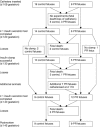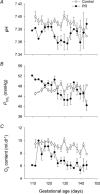Restriction of placental growth in sheep impairs insulin secretion but not sensitivity before birth
- PMID: 17761772
- PMCID: PMC2276990
- DOI: 10.1113/jphysiol.2007.142141
Restriction of placental growth in sheep impairs insulin secretion but not sensitivity before birth
Abstract
Restricted growth before birth is associated with impaired insulin secretion but with initially enhanced insulin sensitivity in early postnatal life, which then progresses to insulin resistance and impaired glucose homeostasis by adulthood. This suggests that prenatal restraint impairs insulin secretion, but increases insulin sensitivity, before birth. Poor placental growth and function are major causes of restricted fetal growth in humans. We have therefore investigated the effects of restricted placental growth and function on plasma glucose, alpha-amino nitrogen and insulin concentrations and glucose- and arginine-stimulated insulin secretion in the fetal sheep at 120 and 140 days gestational age, and on insulin sensitivity, measured by hyperinsulinaemic euglycaemic clamp, at 130 days gestational age. Placental restriction decreased fetal blood pH and oxygen content, and weight in late gestation by approximately 20%. Reduced fetal and placental weights and indices of poor placental function, in particular fetal hypoxia and hypoglycaemia, were associated with impaired glucose- and arginine-stimulated insulin secretion, but not with changes in insulin sensitivity in the fetal sheep. We conclude that the impaired insulin secretion capacity reported in children and adults after intrauterine growth restriction, and in the neonatal and young adult sheep which is small at birth, is present in utero and persists. Whether this reflects the actions of the adverse intrauterine environment or changes to intrinsic capacity is unclear, but in utero interventions may be necessary to improve postnatal insulin secretion in the infant who is growth-restricted before birth.
Figures


 (B) and oxygen content (C) in control (○) and PR fetuses (•). Data are presented as means ±
(B) and oxygen content (C) in control (○) and PR fetuses (•). Data are presented as means ±


Comment in
-
Fetal insulin secretion in late gestation: does size matter?J Physiol. 2007 Dec 15;585(Pt 3):651-2. doi: 10.1113/jphysiol.2007.146811. Epub 2007 Nov 1. J Physiol. 2007. PMID: 17974586 Free PMC article. No abstract available.
Similar articles
-
Sex-specific effects of placental restriction on components of the metabolic syndrome in young adult sheep.Am J Physiol Endocrinol Metab. 2007 Jun;292(6):E1879-89. doi: 10.1152/ajpendo.00706.2006. Epub 2007 Feb 27. Am J Physiol Endocrinol Metab. 2007. PMID: 17327366
-
Impaired beta-cell function and inadequate compensatory increases in beta-cell mass after intrauterine growth restriction in sheep.Endocrinology. 2008 Oct;149(10):5118-27. doi: 10.1210/en.2008-0233. Epub 2008 Jun 5. Endocrinology. 2008. PMID: 18535100
-
Effect of placental restriction and neonatal exendin-4 treatment on postnatal growth, adult body composition, and in vivo glucose metabolism in the sheep.Am J Physiol Endocrinol Metab. 2015 Sep 15;309(6):E589-600. doi: 10.1152/ajpendo.00487.2014. Epub 2015 Jul 28. Am J Physiol Endocrinol Metab. 2015. PMID: 26219868 Free PMC article.
-
Fetal adaptations in insulin secretion result from high catecholamines during placental insufficiency.J Physiol. 2017 Aug 1;595(15):5103-5113. doi: 10.1113/JP273324. Epub 2017 May 26. J Physiol. 2017. PMID: 28194805 Free PMC article. Review.
-
Nutritionally mediated placental growth restriction in the growing adolescent: consequences for the fetus.Biol Reprod. 2004 Oct;71(4):1055-62. doi: 10.1095/biolreprod.104.030965. Epub 2004 Jun 16. Biol Reprod. 2004. PMID: 15201203 Review.
Cited by
-
Effect of pregnancy for females born small on later life metabolic disease risk.PLoS One. 2012;7(9):e45188. doi: 10.1371/journal.pone.0045188. Epub 2012 Sep 13. PLoS One. 2012. PMID: 23028837 Free PMC article.
-
Limited capacity for glucose oxidation in fetal sheep with intrauterine growth restriction.Am J Physiol Regul Integr Comp Physiol. 2015 Oct 15;309(8):R920-8. doi: 10.1152/ajpregu.00197.2015. Epub 2015 Jul 29. Am J Physiol Regul Integr Comp Physiol. 2015. PMID: 26224688 Free PMC article.
-
Prenatal Oxygen and Glucose Therapy Normalizes Insulin Secretion and Action in Growth-Restricted Fetal Sheep.Endocrinology. 2022 Jun 1;163(6):bqac053. doi: 10.1210/endocr/bqac053. Endocrinology. 2022. PMID: 35560217 Free PMC article.
-
The transition from fetal growth restriction to accelerated postnatal growth: a potential role for insulin signalling in skeletal muscle.J Physiol. 2009 Sep 1;587(Pt 17):4199-211. doi: 10.1113/jphysiol.2009.173161. Epub 2009 Jul 21. J Physiol. 2009. PMID: 19622603 Free PMC article.
-
Intrauterine Growth Restriction: Hungry for an Answer.Physiology (Bethesda). 2016 Mar;31(2):131-46. doi: 10.1152/physiol.00033.2015. Physiology (Bethesda). 2016. PMID: 26889018 Free PMC article. Review.
References
-
- Aldoretta PW, Carver TD, Hay WW. Maturation of glucose-stimulated insulin secretion in fetal sheep. Biol Neonate. 1998;73:375–386. - PubMed
-
- Bazaes RA, Salazar TE, Pittaluga E, Pena V, Alegria A, Iniguez G, Ong KK, Dunger DB, Mericq MV. Glucose and lipid metabolism in small for gestational age infants at 48 hours of age. Pediatrics. 2003;111:804–809. - PubMed
-
- Béringue F, Blondeau B, Castellotti MC, Bréant B, Czernichow P, Polak M. Endocrine pancreas development in growth-retarded human fetuses. Diabetes. 2002;51:385–391. - PubMed
-
- Bleker OP, Buimer M, van der Post JAM, van der Veen F. Ted (G. J.) Kloosterman: On intrauterine growth. the significance of prenatal care. studies on birth weight, placental weight and placental index. Placenta. 2006;27:1052–1054. - PubMed
-
- Bocking AD, McMillen IC, Harding R, Thorburn GD. Effect of reduced uterine blood flow on fetal and maternal cortisol. J Dev Physiol. 1986;8:237–245. - PubMed
Publication types
MeSH terms
Substances
LinkOut - more resources
Full Text Sources
Medical

